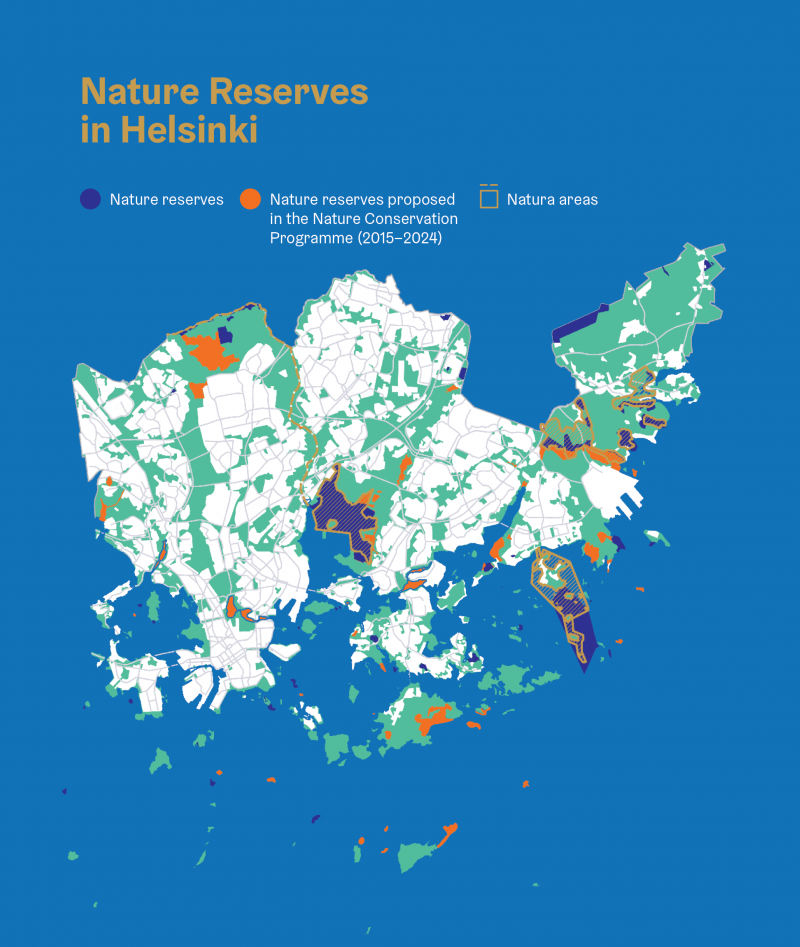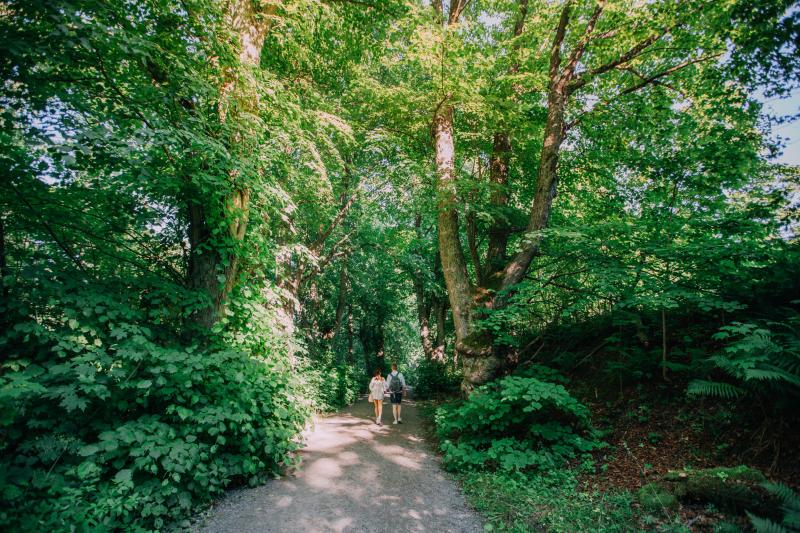Securing biodiversity
In accordance with the City Strategy, Helsinki treasures its valuable nature and works to increase the diversity of urban nature. The ecological quality, accessibility and health effects of green areas will be secured, the Nature Conservation Programme will be implemented and the forest network will be strengthened. The systematic increase of diversity in forests and forested areas is the central objective of the treatment. The green surface area will be increased in the city structure to promote cost-effective management of storm waters, and the diversity of the City’s parks will be increased.
Helsinki’s action programme for securing biodiversity has been prepared by the Urban Environment Division in co-operation with experts and residents. The challenge of the work lies in how biodiversity can be maintained as urban growth and climate change alter the environment. The goal is to maintain biodiversity by improving green and blue networks as well as the conditions of species and nature types.
Biodiversity has been taken into consideration in several significant local detailed plan projects, such as the detailed plans of Karhunkaataja, the Laajasalo tram block, Nallenrinne, Lentoasemakorttelit, Huopalahdenportti, Kutomotie 1 and 9 in Pitäjänmäki, Hakaniemenranta, the Maria start-up campus and Hernesaari, as well as the planning principles for Vartiokylänlahti.
The charting of endangered nature types in 2017–2019 has provided information on the occurrence of critically endangered, endangered, vulnerable and near-threatened nature types in Helsinki. The materials are used to identify Helsinki’s most valuable and representative nature type sites.
According to a survey conducted in 2019, the population of an endangered and important species covered by the EU Habitats Directive, the flying squirrel, has continued to increase rapidly in Helsinki. 35 new forests inhabited by flying squirrels were found, and a total of 124 such forests have been found in recent years. The information has been entered into the City’s Nature Information System (LTJ). The City also conducted a survey on the relationship between the habitats of flying squirrels and their connections and existing and planned land use.
The monitoring of pollinating insects in the City’s green areas began in the spring of 2019. Bumblebees, European honey bees and butterflies were counted with a horizontal alignment calculation method. A total of 21 species of bumblebee were observed. The numbers of species of butterfly and individual butterflies were low, apparently because of drought. Repeating the calculations will produce information on changes to the populations of pollinators in Helsinki.
As the result of inventorying valuable corticioid fungus areas, the City outlined one new valuable corticioid fungus area in a hazel grove located in southern Hallainvuori.
In 2019, the City and Natural Resources Institute Finland collaborated to plan the monitoring of nature, especially forests, and nature indicators. The monitoring of visitors to conservation areas was started as well. The first results were obtained in the Vanhankaupunginlahti area. In 2019, Lammassaari had more than 138,000 visitors.
The monitoring of the nature impacts of archipelago tourism was started in a co-operation project with the Biodiversity Centre of the Finnish Environment Institute. The project examines the wear on vegetation and changes to the occurrence of species caused by nature tourism.

The implementation of the Nature Conservation Programme progressed rapidly. In 2019, the Uusimaa Centre for Economic Development, Transport and the Environment made a founding decision and approved care and use plans for three locations. These are the Kallahti bank, the Maununneva expansion and Korkeasaarenluoto. The Kallahti bank is Helsinki’s only underwater conservation area, and it is home to the underwater meadows of Kallahdenharju and their species. The total area of this extensive area is 228 hectares. At the end of 2019, conservation areas comprised 2.2% of Helsinki’s land area and 0.95% of its marine areas.
The Environment and Permits Sub-committee of the Urban Environment Committee forwarded the founding proposals and care and use plans for five new conservation areas for the City Board and the Uusimaa Centre for Economic Development, Transport and the Environment to process. The areas are Haltialanmetsä and four bird islets: Madeluoto, Pormestarinluodot, Kajuuttaluodot and Morsianluoto. The extensive 137-hectare area of Haltialanmetsä forms the core of an old forest conservation area, and it is firmly connected to other protected sites. Collectively, all the conservation areas form a diverse whole of forests and wildernesses. In accordance with the care and use plan, the nature types of Haltialanmetsä will be restored while also securing their recreational use. Protecting valuable bird islets will ensure peaceful nesting conditions for birds as water transport increases.
Care and use plans will also be created for Särkkäniemi in Uutela and the future Rudträsk, Uutela forest and Skatanniemi conservation areas, as well as Hallainvuori. All of these areas are in active recreational use. Efforts will be made to conserve natural values while also taking the pressures of increasing recreational use into account.
Nature surveys were conducted in future conservation areas in Tahvonlahdenharju and Kruunuvuorenlampi, in the Laajasalo and Jollas areas. The condition of existing conservation areas was charted in the Stansvik grove and mine area, the Jollas swamp and Itäniitynlaakso, as well as the nature type site of the Kruunuvuori linden forest. Nature surveys were also conducted in the future conservation areas of Veräjämäki and the noble deciduous tree grove of the Oulunkylä shore park.
A preliminary survey for a national urban park was prepared in 2019. The survey contains three preliminary national urban park examination areas of different extents and an alternative covering the entire city, which presents the City’s own procedures for meeting the goals prescribed in the national urban park criteria in terms of implementing recreation and nature networks, among other things. Decision-making concerning the matter is still in progress.

Helsinki Zoo celebrated its 130th anniversary with 13 new species in 2019. The new species were the Anthony's poison arrow frog, the turquoise dwarf gecko, the Dumeril's boa, the crested gecko, the Amur leopard cat, the black lemur, the margay, the common Suriname toad, the crested partridge, the Mexican red rump tarantula, the king baboon tarantula, the black-tailed prairie dog and the common kestrel. All in all, Helsinki Zoo has 155 species, with mammals forming the largest group. 28% of the species are classified as endangered.
More than 90 animal babies were born in the Zoo in 2019. Part of Helsinki Zoo’s protection work involves returning animals to nature. Born in Helsinki Zoo, the 4-year-old Przewalski's wild horses Hanna and Helmi were freed among their kind in Mongolia in 2019. The horses’ journey to freedom via practice pens took a year and a half. Successes were also had in the MetsäpeuraLIFE project, the goal of which is to restore the European forest reindeer to its former habitats. Over the course of the year, a total of 21 European forest reindeer were released into the wild from practice pens. Two of the freed reindeer were born at Helsinki Zoo.
The Wildlife Hospital treated more than 1,000 wild animals, a third of which were rehabilitated and returned to nature. Helsinki Zoo and the Friends of Helsinki Zoo Association joined forces to raise a record-breaking €140,000 for different protection projects.
Helsinki has issued instructions for using recycled soil for seedbeds, which are followed in park and green construction projects. Efficient utilisation masses facilitates the utilisation of local species of plants and a seed bank, creates cost savings and reduces transport distances and thus emissions. Examples of implemented sites include Vuosaari Top and Alakivenpuisto.
Construction of the Helsinki metropolitan area’s first light rail, the Jokeri Light Rail, began in the summer of 2019. The environmental effects of the project have been surveyed extensively, and the actual construction will be carried out with the environment taken into consideration as well as possible. Trees will be felled only where necessary for the construction. Felled trees have been transported to untouched forests to secure the deadwood continuum. From Pitäjänmäentie, trees were transplanted to a new location instead of felling. The felling of trees is scheduled so that the nesting season of birds is not disturbed. The Jokeri Light Rail will also feature grass rails that increase the green area in the street space and improve living comfort. The project has involved moving the strictly protected thick shelled river mussels from the NATURA site of the Vantaa River upstream to protect them from the construction project, and the impacts on the core habitats of flying squirrels have been minimised. The Jokeri Light Rail project has also involved acquiring nest boxes for flying squirrels in the future conservation area of Hallainvuori and designing an underpass for small animals in Viikki.
Legislation concerning combating invasive species was tightened on 1 June 2019. The new growing prohibition prescribed in it pertains to the Nootka lupine; the Aleutian ragwort; the Bohemian, the Japanese and the giant knotweed; the Canadian waterweed; the large-leaved lupine; the rugosa rose and the orange jewelweed (Government Decree on Managing the Risk Caused by Alien Species 704/2019, Annex B). The Persian hogweed and the Himalayan balsam were already on the list of invasive alien species of Union concern, and releasing them into nature is prohibited. Invasive species have been combated primarily in connection with other care procedures and through voluntary work events in co-operation with educational institutions, businesses and organisations. Among other measures, invasive species were also combated by taking part in the Healthy Steps into Nature project of the Allergy and Asthma Association of Finland. The Rugosa rose, lupines, the Himalayan balsam and other invasive species have been combated at work sites of the Jokeri Light Rail project. In several locations, sunlit environments for the plants and insects of fields and meadows have been planned on the slopes of the railway. The sunlit fields also combat the spread of invasive species. Invasive mammal species, such as muskrats and raccoon dogs, have been combated primarily in conservation areas. Plenty of Prussian carp have been removed from the largest pond of Vanhankaupunginlahti by fishing, and the local waterfowl populations appear to be recovering there. However, operators in Helsinki have not yet been able to act in a manner required by the new invasive species legislation.
The EU-funded Urban Eco Islands project was started in 2019. A visitor survey concerning the recreational use of Vasikkasaari, the pilot site of the project, was conducted. The project will involve trying how new, innovative and smart solutions can make it possible to develop the delicate archipelago nature to make it suitable for recreational use. The wear on nature was monitored with drone photography, a visitor counter was installed on the island and visitors’ environmental awareness was increased with a live camera installed on the island.
The City of Helsinki, Natural Resources Institute Finland and the University of Helsinki started a research project in the Luukki recreational area, in which endangered species of polypore fungus are transplanted onto felled spruce trees. Natural Resources Institute Finland and the University of Helsinki are monitoring the spread of mycelia in the tree trunks and accompanying species with DNA analyses and the occurrence of fruiting bodies with ground inventorying. The objective of the project is to promote the diversity of forests and restoring endangered species of fungus to their natural growth sites.
Eyes on the future
Securing biodiversity and sustainable use of natural resources must be brought in as part of all of the City’s operations better than before. The development of green and blue networks must be expedited, and wear on nature and the spread of invasive species must be prevented effectively.
